Welcome to the first month of science in 2019! Mr. John worked with us on some very exciting new science experiments.
At the beginning of each science experiment, Mr. John has us come up with our own hypothesis. A hypothesis is an educated guess. Mr. John always tells us that it never matters if our hypothesis is right or wrong, because scientists sometimes are wrong too. We can be just like scientists and learn what works and what doesn’t work.
Don’t forget to check your student’s science paper in their folder every Thursday to see what their hypothesis was for that week’s experiment!
Air Pressure
“Stuck Like Glue”
Question of the week: What will happen if we light a piece of paper on fire inside a glass, turn it upside down, and place it on a plate?
Materials needed to complete this activity at home:
- Paper towels
- A plate
- A piece of paper (the size of a sticky note)
- A lighter
- A glass cup
Our data: When Mr. John lifted the glass, the plate was stuck to it and also lifted.
But why did the plate get stuck to the glass? SCIENCE!
When the piece of paper inside of the overturned jar is lit, the air inside the jar heated, causing it to expand. When the flaming paper is extinguished, the air inside the jar cools and contracts, leaving a void of air within the jar. We created an imperfect vacuum!
Absorption
“To take something in”
Question of the week: What will happen if we pour water in a container containing paper towels and another container containing Sodium Polyacrylate (the stuff in diapers)? Which will hold more water, paper towels or Sodium Polyacrylate?
Materials needed:
- 2 containers
- paper towels
- Sodium Polyacrylate (a diaper)
- A pitcher full of water
Our data: When Mr. John poured water into the container with the paper towels, the paper towels absorbed some water, and some of the water spilled out of the container. When Mr. John poured water into the container with the Sodium Polyacrylate, it absorbed all of the water, and none of the water spilled out of the container.
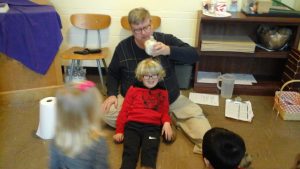
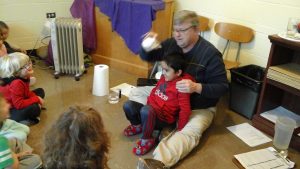
But why did the Sodium Polyacrylate hold more water than the paper towels? SCIENCE
The Sodium Polyacrylate holds more water than the paper towels, therefore it is more absorbent.
Surface Tension
“A property of a liquid keeping an object from going into the luquid”
Question of the week: What will happen if we put a crumpled piece of paper in a glass of plain water and a crumpled piece of paper in a glass with dish soap?
Materials needed:
- Water
- Soap
- 2 containers
- paper
Our data: When Mr. John dropped a crumpled piece of paper into the glass with plain water, it floated. When Mr. John dropped the crumpled piece of paper in the glass with dish soap and water, it sank.
But why did the piece of paper float in the glass with plain water and sink in the glass with dish soap and water? SCIENCE
Water molecules are strongly attracted to each other and this gives water a high surface tension. The surface of water is strong enough to hold up light-weight objects such as paper. Dish soap mixes with water molecules, lowers the surface tension, the hydrogen bonds are weakened or destroyed and the paper sinks. The paper in the glass floats because the hydrogen bonds are intact.
Buoyancy
“A force in a liquid pushing against an object in the liquid”
Question of the week: What will happen if we put a peeled orange and an unpeeled orange in water?
Materials needed:
- An orange
- A peeled orange
- A container
- Water
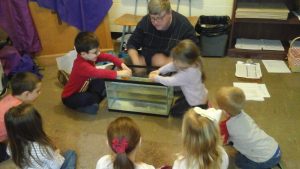
Our data: When Mr. John dropped the oranges in the water, the orange with the peel on floated and the orange without the peel sank.
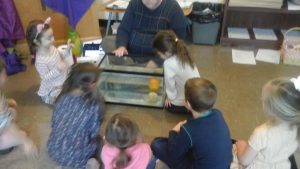
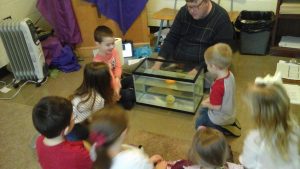
But why did the unpeeled orange float and the peeled orange sink? SCIENCE
The unpeeled orange may be heavier, BUT there is air trapped by the peel making the orange float. The peeled orange has no air so it sinks.
We had so much fun in science this month! Thank you, Mr. John!
